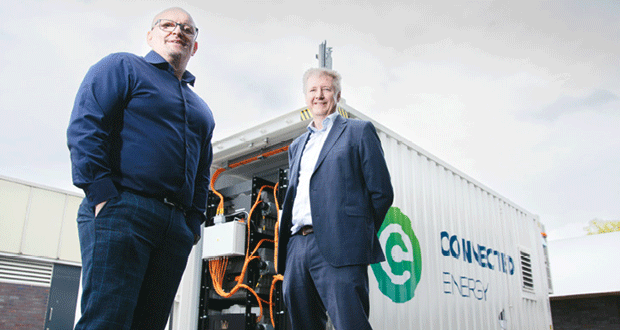Electrifying the fleet is high on the agenda for most FMs. But what do you do if your sites can’t support the new charging infrastructure needed? Matthew Lumsden, CEO of Connected Energy, explains some of the options available
Facilities managers are increasingly expected to be experts in new areas. First it was fleet management, now it is energy management – and these two spheres converge in electric vehicles (EVs).
The first phase of EV adoption was relatively straightforward as most commercial premises only required a few EV chargers. However, as we move into the mass adoption phase, sites will have to install more infrastructure to support the transition. This would not be an issue if we had a grid prepared for wholescale electrification. Instead, we have a grid that is getting better, but in many areas is simply not ready for the big switch to EVs.
EXPENSIVE CHOICES
EV chargers are high load items – they draw down a lot of power from the grid and this obviously rises with each additional charger you install. Many commercial buildings share a grid connection, and to ensure that everyone gets a fair share, the distribution network operator (DNO) sets a limit on how much electricity you can draw down. This is known as your maximum import capacity (MIC), or your kVA allowance. Install too many EV chargers and you will breach your MIC, resulting in surcharges on your energy bills.
If you are lucky, there might be some headroom in your shared connection, and you can pay your DNO to secure it for your business. But in many cases, it either doesn’t exist or has already been grabbed by one of your neighbours. In this instance, if you want more energy, you’re going to have to pay your DNO to upgrade your connection – this is a big capital expenditure and at present has a long lead time due to high demand.
AFFORDABLE ALTERNATIVE
An affordable alternative to a DNO upgrade, or paying MIC excess charges, is to install a battery energy storage system (BESS). These systems are containerised battery packs designed to act as energy reservoirs. They draw down power during quiet periods – ideally overnight when energy is cheaper – and provide it during periods of peak demand.
If you have rooftop solar arrays, a BESS can also help improve the return on investment by ensuring renewable energy is not wasted. If you produce more than you use, the BESS can store that energy for when it is needed. This can help you meet your sustainability goals as well as helping to further reduce energy bills.
If sustainability is a high priority for your organisation, think carefully about what type of BESS you buy. Many use new lithium batteries, with all the environmental impact that entails. However, some companies are now offering BESS using second life batteries, which is much more environmentally friendly.
Connected Energy takes batteries from end-of-life electric vans and gives them a second life in a BESS. These batteries typically still have up to 80 per cent of their energy storage capabilities so are ideal for this application and should still last more than 10 years. In this way, the batteries from yesterday’s EVs can help you power your EV fleet of tomorrow.
CASE STUDY: NORTH TYNESIDE COUNCIL
North Tyneside Council is revitalising its Killingworth site depot, in a multi-million-pound project supported by the European Regional Development Fund (ERDF). The depot – which is home to around 1,000 council staff and partners – now includes a solar PV array and car ports delivering 700 kilowatts at peak generating around 600,00kW/h of electricity per annum. There are also more than 40 electric vehicle (EV) chargers being installed in the coming months, which will increase as the authority transitions a significant part of its fleet to EV over the next few years.
Connected Energy installed its E-STOR battery energy storage system at Killingworth to help optimise its solar energy and support EV charging.
Ian Lillie, Strategic Facilities Manager for North Tyneside Council, with responsibility for the depot, said: “Since installing and commissioning the PV array in February 2023 we have already generated over 100,000kW of green energy. However, we’ve had to give back over 20,000kW to the grid because we can’t store it.
“By using Connected Energy’s battery energy storage system, we can capture that energy and use it to charge our electric vans and indeed the buildings on site overnight. And in the winter, we can use E-STOR to store energy from the grid on lower tariffs at night, to use during the day. The combination of solar and BESS should significantly reduce our electricity bills while also cutting carbon emissions from our energy consumption.
“E-STOR repurposes batteries from end-of-life electric vans, so the ability to power the vans of the future using batteries from the vans of the past was a compelling argument for us. On top of that, the scalability of the E-STOR solution means we can ramp up our use of BESS on site as the Council expands its own EV fleet.”





